When building out your home gym, the best vertical climbers can provide users with a low-impact form of training that can deliver a more high-intensity workout than rowing or running on a treadmill. (1) While some climbing machines can cost upwards of $4,000, the MaxiClimber Vertical Climber is a budget-friendly option for those looking to dip their toes into the world of vertical training. On climbing machines, users step and climb up and down with their hands and feet, with resistance coming from their body weight.
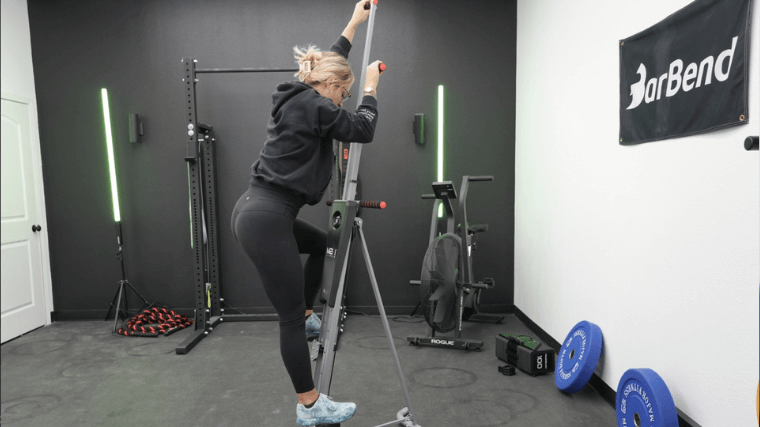
I used the MaxiClimber for about six months when I needed something compact that could fit beside my desk and would help me keep my climbing strength while I was stuck at the office. I enjoyed my experience with this vertical climber, but it’s important to note that, with a price tag of $199, the MaxiClimber isn’t rich in adjustability, tech capabilities, or high-end components. We recommend it as a budget climber for beginners and experienced athletes that are tight on space and looking for quick, HIIT-style workouts that can spike their heart rate. The following is my personal, hands-on MaxiClimber review.

This simple, compact vertical climber can be a great budget-friendly option for full-body training. The MaxiClimber classic also folds up neatly to just 3.02 square feet, which can be ideal for storing your equipment in less spacious environments.
Main Takeaways
- When folded, the compact MaxiClimber shrinks from 7 square feet to just 3 square feet.
- Moving handles and foot pedals provide a total-body workout.
- The compact and lightweight build can only support up to 240 pounds and can feel unstable during use.
MaxiClimber Vertical Climber Highlights
- Price: $199
- Product Dimensions: 86.52” H x 35.82” L x 28.3” W; (folded) 66” H x 15.35” L x 28.3” (unfolded)
- Weight Capacity: 240lbs
- Weight: 33lbs
- Maximum User Height: 6 feet 2 inches
- Build: Plastic and cold-rolled steel
- Warranty: 1-year limited warranty
The MaxiClimber has a compact profile with a 7.04 square-foot footprint that folds down to 3.02 square feet, making it one of the rare vertical climbers suited for small spaces. To help drive home how small this thing can get, it takes up less space than a standard 22 by 22-inch throw pillow when folded.
While some of the best vertical climbers can weigh up to 200 pounds, this machine — a combo of cold-rolled steel and plastic — weighs only 33 pounds. The folding nature and lightweight build made it possible for me to carry it from my Prius (yes, it fits!) to the office. However, due to this construction, it’s definitely one of the least stable vertical climbers our team has tested.
During use, the handles engage your arms and the moving pedals work your legs, allowing for an upper- and lower-body workout. Resistance is dictated by your body weight, so don’t expect to find any adjustment mechanisms. However, if you’d like to up the ante, feel free to throw on a weighted vest for a bit of added resistance.
[Related: The 10 Best Weighted Vests, Picked by Trainers and Coaches]
This unit comes almost totally pre-assembled. All I had to do was put the long vertical arms together, insert them into the main body of the climber, and attach the C-shaped base pieces. Once built, the moving handles can be adjusted up and down, allowing users up to 6 feet 2 inches tall access to training.
You can choose to hold on with a supinated or pronated grip, depending on what part of your upper body you want to target or whichever is more comfortable. Plus, there are stationary handles if you just want to focus on your legs.
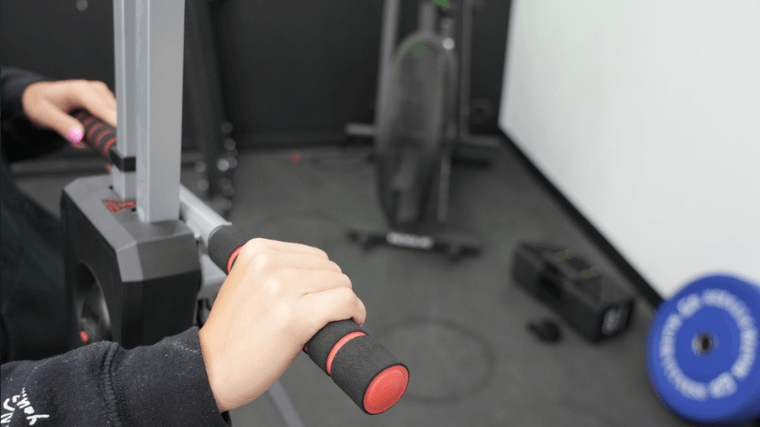
Tech on the MaxiClimber is limited to a small LCD display that counts your steps and calories burned, though I never trust a calorie counter that isn’t clued into my weight and heart rate. The step counter, though, is useful for when you want to test your one-minute workout by taking inventory of how many steps you can get in the allotted time from one week to the next.
Unlike training on an elliptical, treadmill, or exercise bike, where LISS cardio sessions can be paired with reading, working, or watching TV, we think the MaxiClimber is best suited for quick and high-intensity workouts. “Vertical climbers are great tools for someone without a ton of space. And if you can do these workouts for more than 20 minutes, you’re doing it wrong,” notes strength and conditioning coach, Dan Berman, NSCA, CSCS, CPT.
He adds, “Lebron James made these machines very popular.” And who doesn’t want a little of what Lebron’s got?
Pros
- This vertical climber is lightweight, compact, and can fold up to just 3.02 square feet.
- The moving hands and foot pedals provide low-impact cardio that can target upper- and lower-body muscle groups.
- A free MaxiClimber fitness app provides instructor-led lead classes in both English and Spanish.
Cons
- There isn’t any ability to adjust resistance, so users will only have their body weight to work with.
- The lightweight and compact build — paired with the low 240-user weight limit — can make using this machine feel a little precarious.
- There’s no bumper or cushioning at the bottom range of motion for each step, so you’ll have to control your step to avoid banging against the base.
- Some reviews have mentioned this company not assisting with broken or malfunctioning pieces — even when still under warranty.
Training With the MaxiClimber Vertical Climber
I was a staff writer on a Netflix show and it was the first time I ever had my own office. The space had storage closet vibes, but I was thrilled! Since I knew my climbing gym sessions would now be cut short, I purchased the MaxiClimber Vertical Climber, which was compact enough to fit beside my desk. I spent 6 months using this machine and would primarily squeeze in a quick two-minute sprint whenever I needed a little pick-me-up. This left my forehead damp, my heart racing, and my head ready to get to work.
The BarBend team is stacked with personal trainers, former D1 athletes, and CrossFit professionals who’ve tested eight of the most popular vertical climbers on the market. We use a multi-point methodology, rating each product on a scale from 1 (yuck) to 5 (hubba-hubba) in categories such as workout experience, durability, and tech capabilities. Our experience on these machines gave us some crucial context when assessing our time spent on the MaxiClimber.
Simplicity
When bringing a shiny, new piece of fitness equipment into your home, there’s nothing worse than staring down a 50-step assembly process. When this vertical climber arrived, I was able to carry it inside by myself and put it together in about 10 minutes. Delivery and setup scored a 5 out of 5.
[Related: The 11 Best Cardio Machines]
This machine is non-motorized and user-powered, which is great for those who simply want a machine they can hop on and off of when the mood strikes. This also means that the tech on this device is limited, so don’t expect to find any built-in programs or resistance adjustments.
One of our testers noted, “Even without much tech, this device can provide a tough workout. I think most people will be fine working with just their body weight.”
Still, since there’s just a basic LCD display that provides your step and calorie count, we scored the tech capabilities a 2 out of 5.
Total-Body, Low-Impact HIIT
Vertical climbers combine moving arms with moving legs to provide you with a total-body workout. This movement pattern keeps your torso mostly stationary, while your legs push and your arms pull.
Adjusting my positioning on the MaxiClimber helped me target different areas of my body as well. I felt my biceps working with an underhand grip, while an overhand grip lit up my lats. If I dropped my hips back, making sure not to lean back, I could also feel my glutes engage. I would score my overall workout experience a 4 out of 5.
In my opinion, this machine is best suited for quick and efficient high-intensity workouts, rather than low-intensity, steady-state cardio. Strength and conditioning coach Dan Berman, NSCA, CSCS, CPT, uses this type of training with his athletes due to its ability to improve aerobic capacity. (2) “I like to have my high-school athletes finish their workout with a one-minute vertical climber sprint to help increase endurance,” he says.
Additionally, research has shown that the low-impact nature of this workout is easier on the joints, as stress from impact is limited. (3)
Compact, Foldable, and Lightweight
I love rock climbing, and the only thing that gets in the way of me being on par with some of the greats (besides my lack of talent and ability) is how society has forced me to spend my time working rather than climbing. The MaxiClimber was perfect for me, as its footprint of 7 square feet allowed me to squeeze in training that supports my climbing passion from my office.
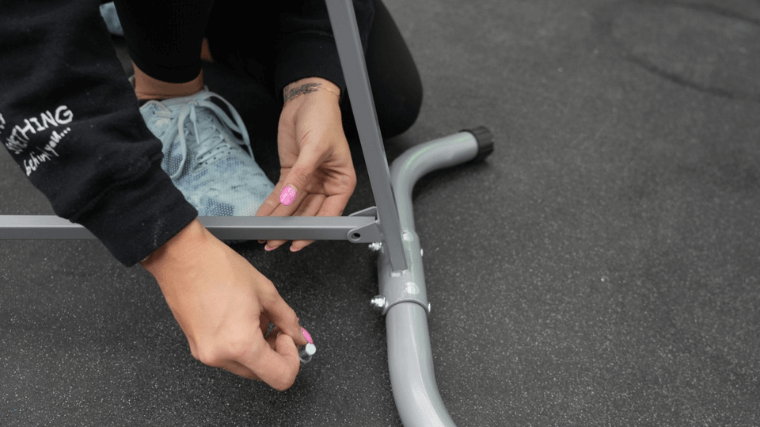
Plus, when folded, it shrinks down to 3 square feet. While I always kept this machine set up and ready to go, I was able to fit it in my Prius after folding it and removing the handles. Transport was no problem, as it weighs just 33 pounds. Other vertical climbers can weigh as much as 200 pounds.
However, this lightweight design comes at the cost of stability. While I always felt reasonably steady on the MaxiClimber, I did feel as if I needed to be totally focused so that I wouldn’t lose my balance. If I tossed some momentum either backward or side to side, I worried that I could tip the whole thing over.
Comfort
The adjustable height handlebars on this workout machine can accommodate users up to 6 feet 2 inches. These adjustments can be made at the bottom of the vertical beam, closer to the foot pedals. All that’s needed is to push a pin and pull the handle to the height you’d like. Even my 6-year-old nephew hopped on — with my supervision, of course, I’m a good aunt — and was able to move the pedals while holding onto the stationary handles.
However, comfort scored a 3 out of 5 in my book. The pedals are small, hard, and uncomfortable. I could only fit the balls of my feet on the pedals, and I wear a size 8.5 women’s shoe. I also found the need to continuously readjust my foot placement throughout my workout in an effort to get comfortable.
What to Consider Before Buying the MaxiClimber Vertical Climber
“These cardio machines provide a full-body workout without putting undue stress on the joints,” notes Amanda Capritto, CPT, CES, CNC, CF-L1, CSNC. That said, they’re unlike typical at-home cardio machines we’ve tried and tested. When considering a budget vertical climber over the best budget exercise bikes, treadmills, or ellipticals, consider the following areas.
Training Capabilities
Vertical climbers can deliver low-impact, total-body cardio, but the type of training that the MaxiClimber provides might not suit those more interested in low-intensity, steady-state cardio. When I would work out on my MaxiClimber, the longest amount of time I could go for was about five minutes before I needed to hop off and pace the room with my hands on my hips.
If you want built-in programming to help structure your workouts, you may want to look elsewhere. While there is a free MaxiClimber app, there are currently only 12 pre-recorded workouts to follow or a 21-day Maxi-Challenge that has audio-only guidance.
I tried out one of the audio-only workouts, and while I appreciated some of the cues to “tighten that core” or “feel this in your tricep and glutes,” I wouldn’t want this wall-to-wall audio-only coaching, which felt inauthentic due to callouts like “that’s it!” and “good job!” I’m not doing a good job, I’m just sitting at my desk listening.
Additionally, there’s no media stand to hold your phone or tablet, so if you want to take on any of the 12 pre-recorded workouts, you’ll need to set your device up on a nearby chair or table.
Stability and Weight Capacity
The industry standard for most cardio machines is a weight capacity of around 300 pounds. These weight limits are supported by durable aluminum or steel frames and quality builds, backed up by at least five-year warranties.

Budget-friendly options will often have less impressive warranties and lower user weight capacities, as is the case with the MaxiClimber’s one-year warranty and plastic and cold-rolled steel build, which supports users up to 240 pounds.
[Related: Your Guide to Creating Fitness Goals — And How to Crush Them]
A low weight limit is a strong signifier that the build of the equipment is less durable than others. I’m about 125 pounds, and I often felt a little unsteady during workouts. The footpads are small, and there aren’t any straps to keep you secure. Also, the base is compact, so I worried that if I leaned back I might tip the entire thing over. However, that’s generally the case with budget buys. Since the MaxiClimber is priced between $200 to (gasp) $4,000 less than other popular models, the lack of stability may be acceptable for your purposes.
Durability
I never had a problem with my MaxiClimber breaking, and I used it every other day for about six months. However, it’s worth noting that the build consists of a lot of plastic.
A common complaint in customer reviews is the rollers that move the handles up and down. “The tracking wheels look solid, but they can’t handle a 190-pound person using the machine. They stick and then wear prematurely or snap in half,” mentions one review.
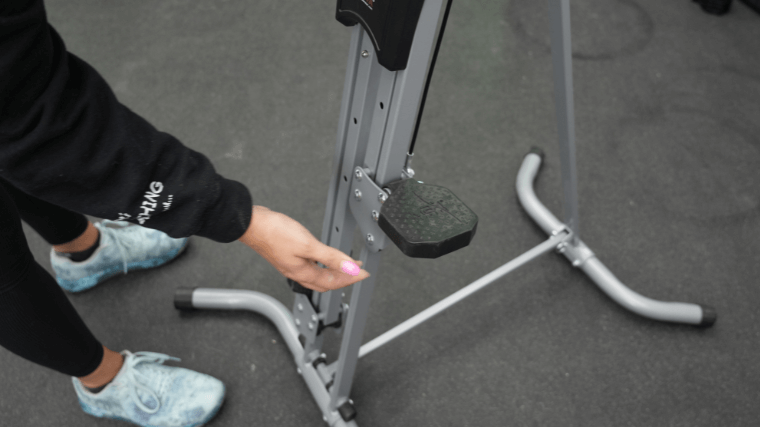
“Within 6 days [of purchase] one of the rollers gave out! A piece of plastic broke off, making it unable to roll,” noted another.
There is a one-year warranty, but reviews on customer service seem to be hit or miss. While some users have had replacement wheels sent to them, others say: “Buyer beware — it will break, and nothing will be done about it.”
MaxiClimber Vertical Climber Vs. the Competition
There are some awesome vertical trainers on the market — and we should know, we’ve gotten the chance to test eight of them. The chart below is a quick comparison between the MaxiClimber and its competition.
| MaxiClimber Vertical Climber | ProForm Carbon HIIT H10 | CLMBR Connected 02 | MaxiClimber XL 2000 | Relife Rebuild Your Life Vertical Climber | |
| Price | $199 | $1,404 | $3,995 | $399 | $399.99 |
| Weight Capacity | 240lbs | 325lbs | 350lbs | 300lbs | 260lbs |
| Product Dimensions | 86.52” H x 35.82” L x 28.3” W | 66.7” H x 52” L x 29.25” W | 88” H x 35” L x 32” W | 92.88” H 41.33” L x 25.78” W | 85” H x 37.5” L x 28” W |
| Foldable? | Yes | No | No | Yes | Yes |
| Resistance | Bodyweight | 24 levels of Silent Magnetic Resistance | 11 levels | 12 levels of hydraulic piston resistance | Bodyweight |
| Weight | 33lbs | 225lbs | 180lbs | 51lbs | 44.75lbs |
| Tech Features | Basic LCD screen with calorie and step counting | 10” HD touchscreen, plus a 3-year membership to iFIT programming | 21.5” HD touchscreen with optional subscription to integrated programming | None, but built-in mobile device holder | Basic LCD screen with time, step count, calories, and fat burn |
While the MaxiClimber is one of the most affordable options on the market, the two closest competitors come in at $399 — almost double the price. The Relife Rebuild Your Life Vertical climber uses metal slideways that support the arms, as compared to the plastic rollers that are used on the MaxiClimber Vertical Climber.
The MaxiClimber XL 2000 is a top-of-the-line offering from MaxiClimber, providing 12 levels of adjustable hydraulic resistance as compared the Vertical Climbers’ lack of adjustable resistance. It also provides a full foot pad, unlike the small and uncomfortable foot pad offered on the Vertical Climber.
The ProForm Carbon HIIT H10 and CLMBR Connected 02 are two more costly climbers, but these options provide the sort of technology that some users may want to consider. While these machines both have built-in touchscreens and integrated app streaming, their apps come with an additional subscription fee. However, the ProForm Carbon HIIT H10 provides three years of an iFIT subscription with your purchase, which is a great deal.
While the MaxiClimber Vertical Climber lacks tech features, resistance adjustments, and has one of the lowest user weight capacities, this device is still the most compact stepper and costs just a fraction the cost of the competition. Plus, we think it’s one of the best stair climbers we’ve tried and tested.
Places to Buy the MaxiClimber Vertical Climber
You can purchase the MaxiClimber Vertical Climber via Amazon, Walmart, or the official Maxi Climber website.
Customer Experience
This vertical climber ships for free from Amazon and it was easy-breezy-beautiful to put it together. I put it all together in about 10 minutes, then was able to take the handles off, fold it up to fit it in my Prius, and take it to work.
There are over 10,000 reviews on Amazon, with more than 80% earning 4 and 5 out of 5 stars. Users like the low-impact nature of this vertical climber, the ability to raise their heart rate in an efficient workout, and the ease of storage. One customer review mentioned, “It didn’t hurt my joints at all… Within five minutes I had already worked up a major sweat. My arms, legs, and abs are still burning as I type this. I am optimistic that this thing might actually help me get back into shape!”

There’s a one-year warranty, but we’ve seen some mixed reviews about how well customer service responds to issues raised. This gives us pause, considering that many of the moving parts are made from plastic pieces which can break.
While I didn’t have a problem with my MaxiClimber, I think this is part of the gamble with budget equipment. However, Amanda Capritto, CPT, CES, CNC, CF-L1, CSNC, notes that this sort of low-priced equipment is best for “people who don’t have a ton of money to spend but are ready to prioritize their health.”
Warranties
There is a one-year warranty offered with purchase, plus the ability to add on a two-year protection plan for an additional $21.99 with Amazon. There’s also an Asurion Complete Protect plan that covers all eligible past and future purchases, but this costs an additional $16.99 a month, which doesn’t seem worth it since a full year of this coverage would come out to $203.88. You could just use that money to buy a brand new machine.
Company Information
Inova US owns the MaxiClimber brand, as well as Aeroski, Fitt Cube, and Skoon, to name a few. To speak with a representative from Inova, you can email them at contact@inovaus.com or by phone at 888-339-2990.
MaxiClimber first appeared on the market in 2014. You can get in touch with MaxiClimber’s customer service via their website, help@maxiclimber.com, or by phone at 888-433-9083.
In Conclusion
The MaxiClimber Vertical Climber is a bare-bones cardio machine that’s affordable, easily transportable, and can provide users with an intense body-weight training session. While the 240-pound max user weight and use of plastic in its build may have users worried about longevity, the price is nearly half the cost of the next lowest-priced vertical climber on the market. So, if you’re unable to spend more — or if you’re unsure if you’ll like vertical climbing — this is a good option to try out.
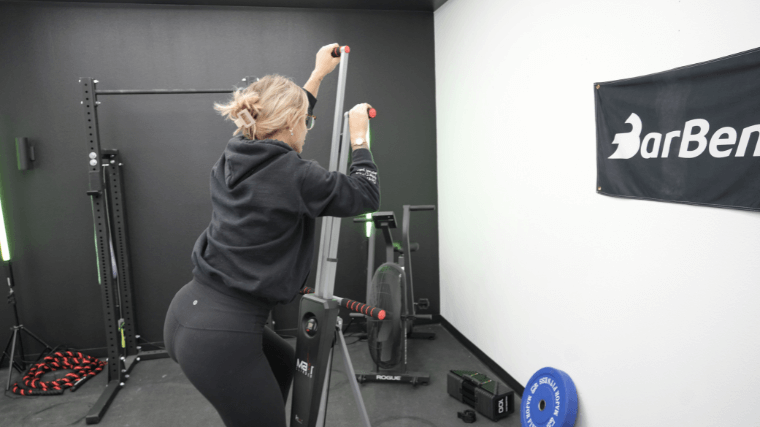
If you’re looking for a cardio machine with adjustable resistance and built-in programming, you won’t find it here. (You’ll also need to be prepared to spend between $1,404 and $4,000.) But while the MaxiClimber Vertical Climber lacks tech features or the ability to increase resistance, I still think it’s a worthwhile investment for those wanting a compact and affordable exercise machine suitable for all fitness levels. Just don’t expect the machine to last forever.
FAQs
How much does MaxiClimber Vertical Climber cost?
Available on Amazon, Walmart, and the company website, the MaxiClimber Vertical Climber costs $199.
Does the MaxiClimber Vertical Climber really work?
The MaxiClimber is a cardio workout that’ll help to work your glutes, arms, legs, and core. But since the machine doesn’t have a motor, you need to work for the MaxiClimber to work. While there isn’t the ability to adjust resistance, users can choose the speed at which they move, add additional time to their cardio session, or wear a weighted vest to provide an added challenge.
[Related: Demystifying Your Fat-Burning Heart Rate Zone]
Can you lose weight with the MaxiClimber Vertical Climber?
MaxiClimber’s website claims that this machine has been proven to burn double the calories in comparison to a typical treadmill or stationary bike. From my experience, this machine definitely elevated my heart rate, which can be a calorie-burning furnace. Whether or not that’s true, physical fitness paired with a healthy diet is one of the best ways to approach weight loss. (4)
References
- Brahler, C. J., & Blank, S. E. (1995). VersaClimbing elicits higher VO2max than does treadmill running or rowing ergometry. Medicine and science in sports and exercise, 27(2), 249–254.
- Gist, N. H., Fedewa, M. V., Dishman, R. K., & Cureton, K. J. (2014). Sprint interval training effects on aerobic capacity: a systematic review and meta-analysis. Sports medicine (Auckland, N.Z.), 44(2), 269–279. https://doi.org/10.1007/s40279-013-0115-0
- Physical Activity for Arthritis. Centers for Disease Control and Prevention. (2022) https://www.cdc.gov/arthritis/basics/physical-activity/index.html
- Swift, D. L., McGee, J. E., Earnest, C. P., Carlisle, E., Nygard, M., & Johannsen, N. M. (2018). The Effects of Exercise and Physical Activity on Weight Loss and Maintenance. Progress in cardiovascular diseases, 61(2), 206–213. https://doi.org/10.1016/j.pcad.2018.07.014